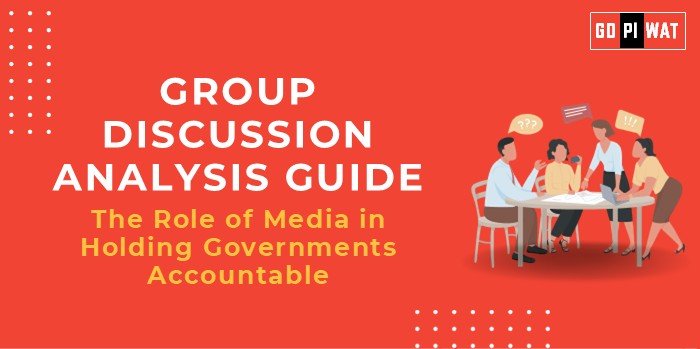📋 Group Discussion (GD) Analysis Guide
🌐 Topic: The Role of Media in Holding Governments Accountable
🌟 Introduction
Media serves as the fourth pillar of democracy, ensuring transparency and accountability in governance. In recent years, its role has expanded with the advent of digital platforms, fostering real-time dialogue while also amplifying challenges like misinformation and censorship.
📊 Quick Facts & Key Statistics
- 📉 Global Press Freedom Index Rank (2023): India ranked 161 out of 180, signaling serious press freedom concerns.
- 🌐 Internet Penetration Worldwide: As of October 2024, 5.04 billion people (62.6% of the global population) are active social media users, underscoring the media’s vast reach.
- 📰 Journalist Deaths in 2023: 94 journalists were killed, with heightened violence during the Gaza conflict (Source: International Federation of Journalists).
- ⚠️ Misinformation Statistics: One-third of American social media users rarely trust online information, demonstrating the widespread impact of misinformation.
🧑🤝🧑 Stakeholders and Their Roles
- 🏛️ Governments: Regulate media, balance freedom and security.
- 📺 Media Organizations: Investigate and report objectively.
- 🌍 Civil Society: Advocate for transparency and fact-checking.
- 💻 Tech Platforms: Moderate content, reduce fake news spread.
- 🌏 International Bodies: Monitor press freedom and human rights violations.
🏆 Achievements and Challenges
🎉 Achievements:
- 💡 Transparency in Governance: Whistleblower platforms have exposed corruption worldwide.
- 📣 Awareness Building: Media campaigns have driven policy changes on critical issues like climate change.
- 🌐 Digital Media: Social media democratized discourse, enabling grassroots movements like #MeToo.
⚠️ Challenges:
- 🔒 Censorship: Governments increasingly suppress dissenting voices (e.g., internet shutdowns in Myanmar).
- 🛡️ Journalist Safety: Rising attacks on journalists, especially in conflict zones.
- ⚡ Misinformation: Propagation of fake news undermines public trust.
🌍 Global Comparisons
- 🇳🇴 Norway: Tops the Press Freedom Index with a robust framework for media independence.
- 🇷🇺 Russia: Censorship and state control of media limit transparency.
📋 Case Study:
- 🇮🇳 India: Investigative journalism has exposed scams like the 2G spectrum case but faced backlash from authorities.
🗣️ Effective Discussion Approaches
📌 Opening Approaches:
- 📉 Highlight India’s Global Press Freedom Index rank to set the stage.
- 📖 Use case studies like the Watergate scandal to emphasize investigative journalism’s impact.
🎭 Counter-Argument Handling:
- Acknowledge biases but propose solutions like independent regulatory councils.
- Emphasize the need for balancing security with media freedom.
🔍 Strategic Analysis of Strengths & Weaknesses
- ✅ Strengths:
- Ubiquity of media platforms.
- Vital role in governance.
- ❌ Weaknesses:
- Concentration of media ownership.
- Vulnerability to propaganda.
- 📈 Opportunities:
- Collaboration with international watchdogs.
- Enhanced fact-checking using AI.
- ⚠️ Threats:
- Censorship.
- Physical threats to journalists.
- Algorithmic bias.
📖 Structured Arguments for Discussion
- ✅ Supporting Stance: “A vigilant media is democracy’s strongest ally in ensuring accountability.”
- ❌ Opposing Stance: “Sensationalism and misinformation often diminish media’s credibility.”
- ⚖️ Balanced Perspective: “While media holds power to drive transparency, ethical lapses can undermine its mission.”
🎓 Connecting with B-School Applications
- 📘 Real-World Applications:
- Governance and ethics projects.
- Media’s role in corporate social responsibility.
- 📋 Sample Interview Questions:
- “How does press freedom correlate with economic development?”
- “What reforms can strengthen the media’s accountability role?”
- 💡 Insights for Students:
- Media literacy is critical for effective corporate communication.
- Future leaders must navigate and address the challenges of misinformation.


